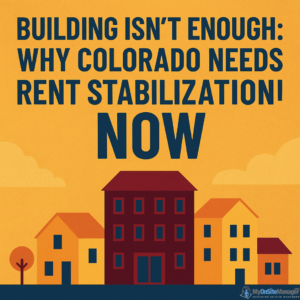In cities across Colorado, cranes fill the skyline and new apartment complexes seem to rise overnight. And yet, for many renters, relief remains out of reach. Despite an increase in housing supply, rents continue to climb, leaving countless families struggling to stay in their homes. Why?
The answer lies in a growing realization among housing advocates and economists: building more units alone won’t solve the affordability crisis—not when renters remain vulnerable to sudden, drastic rent hikes. That’s where rent stabilization comes in.
What Is Rent Stabilization—and Why It Matters
Rent stabilization is often misunderstood. It’s not the same as rent control, which typically imposes strict caps or freezes on rent increases. Instead, rent stabilization allows for modest, predictable rent increases—typically tied to inflation—while still providing landlords with flexibility and revenue to maintain their properties.
Colorado’s proposed approach to rent stabilization is especially thoughtful:
-
New buildings would be exempt for 15 years, so development isn’t discouraged.
-
Rent increases could still happen, just at a fair and predictable pace.
-
Local governments—not the state—would be in control, allowing policies to be tailored to each city’s needs.
This isn’t a radical experiment. Cities like Los Angeles, San Francisco, and many in New Jersey already use similar models. And they’ve shown that rent stabilization can work—if done right.
Why “Build More” Hasn’t Worked on Its Own
There’s a persistent myth in housing policy: if we just build more, rents will fall. It’s true that increasing supply can help reduce long-term pressure—but the benefits often take years to materialize, and they don’t always trickle down to those who need it most.
In booming areas like Denver and Boulder, rents have skyrocketed despite a surge in new construction. Incomes, especially for service workers and low-income families, haven’t kept pace. Many renters have been pushed out of their communities altogether—forced to move far from work, school, and support networks.
What’s more, when demand remains high, landlords can raise rents with little consequence. That’s not a free market—that’s an imbalanced one. Rent stabilization restores a measure of fairness.
The Research Speaks Volumes
Critics of rent stabilization often cite concerns about reduced maintenance or lower construction. But the data tells a more nuanced story:
-
Tenant stability improves dramatically. People stay in their homes longer and face fewer forced moves.
-
Racial equity is strengthened. Communities of color, often disproportionately affected by rising rents, benefit most from these protections.
-
Modern policies protect against unintended consequences. Colorado’s proposal, by exempting new construction and allowing reasonable increases, avoids the “classic” pitfalls of older rent control models.
In places like New Jersey, where rent stabilization is common, there’s been no significant drop in housing quality or development—just more predictability for renters and landlords alike.
What the Colorado Bill Would Do
If passed, Colorado’s bill would:
- Let cities decide whether to adopt rent stabilization
- Cap rent increases to a set percentage above inflation
- Exempt new construction for 15 years
- Allow landlords to raise rents for capital improvements or when units turn over
This is not a statewide mandate. It’s an invitation for local communities to act—especially in places where the rent burden is highest.
The Stakes Are High
Opponents, including Governor Jared Polis, argue that rent caps could stifle new development. But supporters believe the bill strikes the right balance between market flexibility and renter protection.
With more than a third of Colorado renters considered “rent burdened” (spending over 30% of income on rent), and some cities seeing annual rent increases of 10% or more, doing nothing is no longer an option.
Housing insecurity isn’t just an economic issue—it’s a human one. Kids forced to change schools, seniors evicted after decades in the same neighborhood, workers commuting hours because they can’t afford to live where they work—all of these are symptoms of a system out of balance.
Rent stabilization won’t fix everything. But it can slow the bleeding.
Final Thoughts
Colorado stands at a crossroads. On one path: an unchecked rental market that continues to price out essential workers and vulnerable residents. On the other: a measured, evidence-based policy that offers communities the tools to stabilize rents, protect tenants, and preserve neighborhood integrity.
We’ve built the units. Now it’s time to build protections too.
Source: When Building More Isn’t Enough: The Case for Rent Stabilization in Colorado

